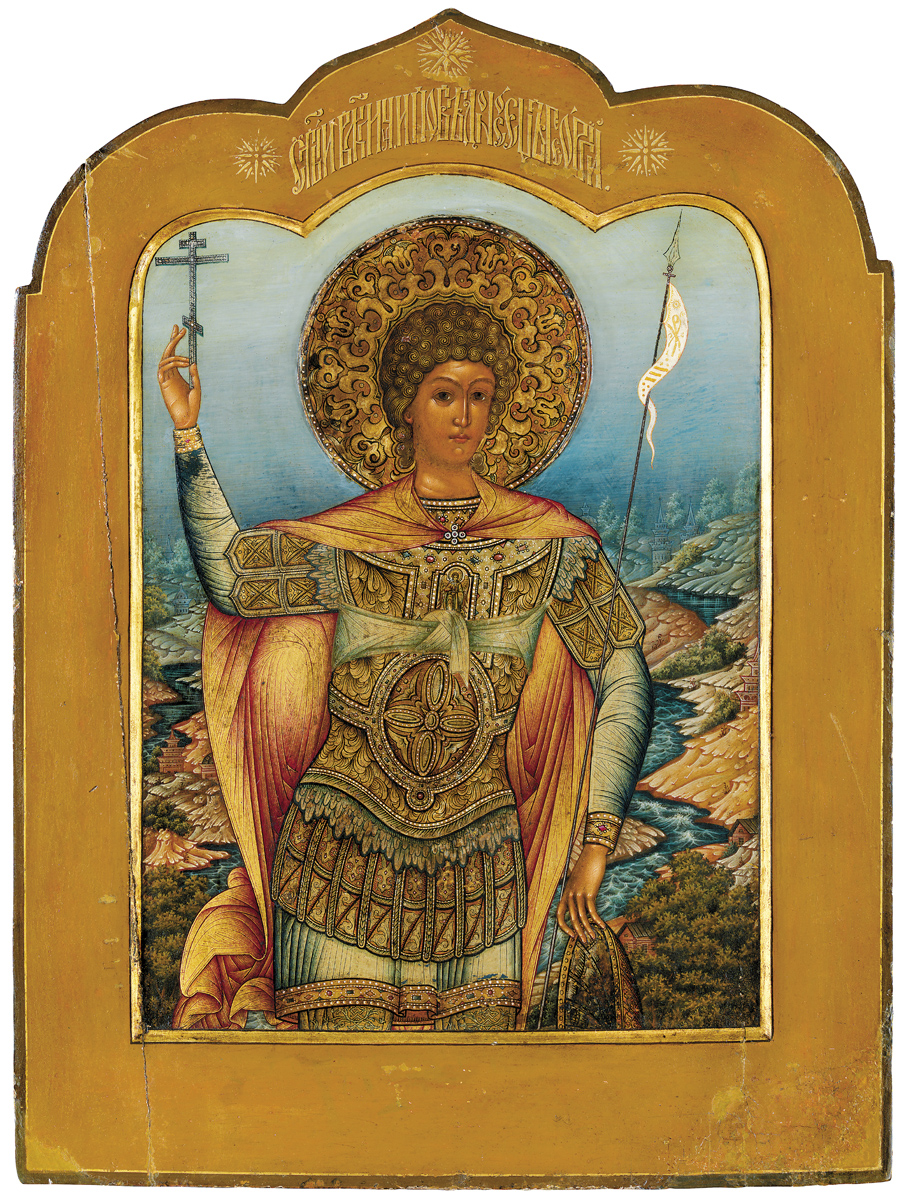MacDougall's Russian Art Auctions 1-2 Dec 2010
1 December 2010

608. AN EXCEPTIONAL ICON OF THE GREAT MARTYR GEORGE "THE VICTORIOUS"
MOSCOW, WORKSHOP OF MSTERA MASTER O.S.CHIRIKOV (?), END OF THE 19TH TO BEGINNING OF THE 20TH CENTURY WITH A METAL HALO
35 by 26.5 cm
25,000-30,000 GBP
The icon is a shining example of the professional icon painting of Mstera. The inscription that appears in the upper border is: "THE HOLY GREAT MARTYR AND BRINGER OF VICTORY GEORGE". The great martyr George is depicted standing against a detailed landscape background; the fingers of his right hand forms the sign of the cross and he holds an eight-armed cross, in the crook of his left arm is a thin spear with a white pennant inscribed with the monogram of Christ; with the same arm he holds a shield. These attributes point to a direct connection between the icon and the milieu of the Old Belief, not only when one pursues the line of the artist (the majority of icon painters from Mstera, including such well known names as M.I. Dikarev and O.S. Chirikov, were Old Believers), but also on the patron’s side. Such depictions of saints — making the sign of benediction and with an eight- armed cross — were banned by the Great Synod of Moscow in 1667 and preserved only amongst the Old Believers. The edge of the upper border of the icon is three-lobed, with the top of the middle lobe ending in the shape of an up- turned keel. The figure of the holy warrior is skilfully painted into this complex shape, implying that the composition was thought through at the outset. The icon has refined colouring: it is executed in bluish and ochre tones and the repeated use of these colours and tints over the entire surface of the icon unifies the figure and the landscape into a single entity.
The gold chamfer surrounding the picture itself is perceived as a narrow gilded frame and the painting is distinguished by the fine miniaturism so characteristic of the Mstera school, whose well-known masters possessed astonishing skill. St. George’s rich armour is finely painted: the chased rendering of the corselet, the gorget, wristbands and skirt of the tunic, the little icon of a Guardian Angel on the breast and the clasp fastening the cloak — are all decorated with precious stones and strings of pearls. The rock ledges, the turbulent torrent and the clumps of trees that make up the background are all skilfully painted and the emphasis on the landscape is a brilliant distinguishing feature and an important conceptual and decorative part of the icon. The features we have noted of "St. George the Victorious" mean that it must bear comparison with the work of the greatest masters of this school, Mikhail Ivanovich Dikarev and Osip Semyonovich Chirikov. From 1884-1903, Dikarev and Chirikov worked together on an extensive menological series of icons for the Chapel of the Presentation of the Virgin at the Grand-Ducal Marble Palace in St Petersburg (376 icons). The landscape painting in the menological series was unusually fine and constructed using the rules of perspective. The low horizon emphasised the grandeur of the saint’s figure; the beauty of the landscape (often incorporating churches, monasteries, and panoramas of cities) would be called upon to show the beauty and harmony of God’s creation. All these special characteristics apply fully to our "St. George the Victorious" icon, which means it can be legitimately linked with the aforementioned masters or their workshops. Art historians have drawn attention to the fact that the works of Dikarev and Chirikov are marked by a common style. It seems therefore, there are good grounds why this icon should be attributed if not to Chirikov himself (the icon does not have the artist’s signature on it), then to his workshop. The historic artefacts from the menological series now kept in the State Hermitage, the State Russian Museum and the State Museum of the History of Religion, allow a difference to be discerned in the way landscape is depicted in the icons of Dikarev as opposed to those of Chirikov. The influence of academic painting and the rules of perspective are more noticeable in the works of the former of these two masters. The manner of Chirikov is dominated by traditional methods of icon painting: the horizon on his icons is, as a rule, higher and the landscape is more conventional and fragmented, always incorporating
rock ledges and hillocks, and clumps of trees. It is precisely these special features that predominate in the landscape of our "St. George the Victorious" icon. Thus, the particular features of the design, composition and artistic style of the "St. George the Victorious" icon indicate that it was commissioned under a special individual order and represents a unique example of late 19th to early 20th century icon painting of Mstera. It is likely that this image, full of deep inner meaning and expression, and distinguished by the refinement of the colours and restrained ornamentation, was made in the Moscow workshop of the famous icon painter from Mstera, Osip Semyonovich Chirikov.
Notes on symbols:
* Indicates 5% Import Duty Charge applies.
Ω Indicates 20% Import Duty Charge applies.
§ Indicates Artist's Resale Right applies.
† Indicates Standard VAT scheme applies, and the rate of 20% VAT will be charged on both hammer price and premium.